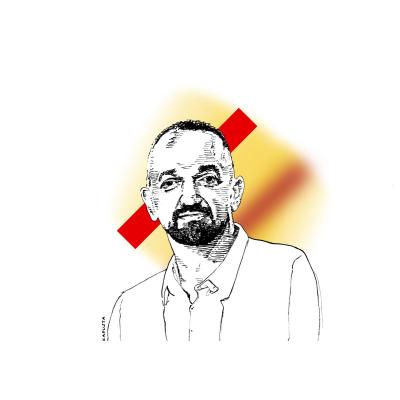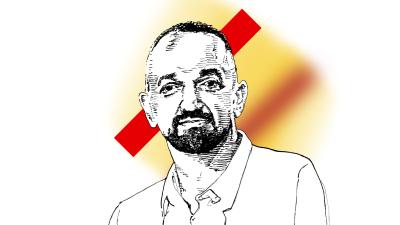Darío Madrid: “It is not necessary to defend a pink legend of the Inquisition, but simply to put it in context”
Darío Madrid is the internet pseudonym of Gonzalo Fernández, a historical researcher and lawyer. Specialised in Criminal and Labour Law, in the field of history he has written numerous articles related to the Black Legend, the Inquisition and the Conquest of America, and has been invited as a speaker at various history conferences and meetings. He was awarded the Universitas Summa Cum Laude medal by GEES Spain for his work in disseminating Spanish history. We talked about his first book, "La Inquisición española. Realidad y procedimiento del Santo Oficio" (The Spanish Inquisition. Reality and procedure of the Holy Office), a work that clearly sets out what the proceedings before the Inquisition courts were like.
Álvaro Peñas: Why a book about the Spanish Inquisition?
Darío Madrid: It is a subject that has always attracted my attention. In fact, I bought my first book on the Inquisition in 1984. I like history and the history of the Spanish Inquisition is very interesting, especially when you discover that they didn't use the instruments of torture that are shown in films, museums and exhibitions, such as the iron lady, the Judas cradle or the breast-puller. The latter is a good example of what I am talking about. The journalist Antonio Maestre took a painting of the martyrdom of Saint Agatha, in which the Romans tear off her breasts, and described it as an Inquisition torture. Torture, yes, but not with these inventions of terror. And then I'm also very struck by the procedure because I'm a lawyer. It was very strict and absolutely everything was written down, even the exclamations of pain of the tortured. So four years ago I started researching this issue and finally wrote this book.
The fact that they wrote everything down is the great demystifier of the inquisition.
Exactly. If the whole case files don't exist, there is the summary or the sentence. That is why we know that in the period between 1540 and 1700, those executed accounted for 3% of the people prosecuted, i.e. around 3,000. This is a far cry from the figure of more than thirty thousand of Juan Antonio Llorente, the first person to write a book on the Inquisition.
The figure is very low for what happened at that time with the religious wars and the rise of Protestantism.
Yes, if we take into account, for example, what happened in France on the night of Saint Bartholomew, five days in which 15,000 Huguenots were murdered. Or England, where the figures are not very clear, but we know that Henry VIII persecuted Catholics, his daughter Mary, who was a Catholic, persecuted Anglicans, and Elizabeth again persecuted Catholics. There was no religious tolerance at that time. What happened is that the Spanish Inquisition lasted longer than other religious institutions, although in the end its function was to watch over good morals.
Unlike the civil courts, in the Inquisition trials there was a defence lawyer.
There was a defence lawyer, but he was appointed by the court and was an official of the court. His task was to defend the defendant and to point out any irregularities in the proceedings, although this was not at all common because the inquisitors were very meticulous. In fact, they enjoyed a lot of prestige and were highly regarded at that time.
So, was the Inquisition more protective of the accused than a civil court?
On the issue of torture it was. Torture was applied everywhere, but in the Inquisition they were strict. In a civil court it was up to the judge's discretion, whereas the inquisitors had to follow rules. Moreover, in the Inquisition, torture was applied at the end of the proceedings, when the investigation had already been carried out, but in civilian courts it was usually done at the beginning. The inquisitors were much more regimented.
The Inquisition did not really seek the condemnation of the sinner, what it sought was repentance. Therefore, those who repent were saved and only those who did not repent or repent too late were condemned to the stake or the galleys, depending on the crime. In fact, for the time, the sentences were not so harsh, because repentance was what was sought. Even life sentences often ended after a few years and there was the possibility of serving the sentence at home. The worst part was at the beginning of the procedure, when the suspect entered the secret prison and could spend years inside. For example, Fray Luis de León spent four years in prison before being tried.
However, the perverse image of the inquisitor has become popular. This image was born as a propaganda attack against Spain because at that time it was the “Sword of the Church”, but, in general, don't you think there is an attempt to demonise the Catholic inquisition but not the Protestant inquisition?
The fact is that all these attacks came from Dutch Protestants who, just as they used the conquest of America as propaganda against Spain, also used the Inquisition as a battering ram and exaggerated it greatly. For example, the book "Artes de la Inquisición Española", published in 1567 by Reinaldo González Montano, who was the pseudonym of a Spanish Protestant believed to have fled from Valladolid, is a catalogue of barbarities that forms the basis of the black legend about the Inquisition. But the persecutions carried out by the Protestants are tremendous. The Calvinists executed 500 people in a town of 3,000 inhabitants. Or the famous case of Miguel Servet, condemned by Calvin, but which many blame on the Spanish inquisition, just as many mistakenly believe that Galileo was burned by the church.
Is the inquisition now a weapon to attack the church?
Yes, it is for the Left, which uses the inquisition in its ongoing attack on the church.
The problem is that this propaganda has become popular culture. In Hollywood films released this year, the Spanish Inquisition is referred to as "the darkest period of the church".
What is forgotten is that at that time all countries were persecuting heresy. And heresy was then the worst of crimes, but this happened everywhere. That is why Calvin, who had escaped the French Inquisition, burns Servet for writing a heretical book.
Not only in Hollywood, in Spain the myth lives on very strongly.
Yes, here the image of a dark Spain and a dark church, where the inquisitors are sinister characters, is sold a lot, but this does not mean that we have to defend a pink legend of the inquisition, we simply have to put it in context. For example, there are cases of people who were denounced to the inquisition for blasphemy and were taken to the secret prison, where they remained locked up for a year until the penalty was decided, which in some cases consisted of praying the Our Father several times, but of course they spent a whole year in prison. The point is that this also happened in other countries and the most brutal example is that of the witches.
In Spain there were no witch hunts like in Germany, France or Switzerland, why?
Well, thanks to the Inquisition. The first regulation that appears in Spain dates back to 1525, and it says that these stories should not be believed, that witches do not exist and that they may be sick, mad or lying women. After the sadly famous “auto da fe” (inquisitorial trial) of Logroño, that of the witches of Zugarramundi, in which six people were burnt and five died in the proceedings, the famous inquisitor Alonso de Salazar insisted that this could not happen again. This is why the number of witches burned in Spain is counted by the dozens, while in Europe, where many educated people believed that witches had relations with the devil and flew on broomsticks, they are counted by the tens of thousands.
However, there are still many in Spain who believe they are the granddaughters of the witches who could not be burnt...
Sure, but it's not real. They are like the museums of the Inquisition, which are completely false. None of the pieces on display were used by the inquisitors, not even the famous rack. In Spain we have two torture museums, in Santillana del Mar and Toledo, where these contraptions are exhibited, and in Granada it is directly called the museum of the Inquisition. In the latter you can see the iron lady and all kinds of instruments of torture, such as the inquisitorial chair, a chair with the back and seat full of nails where the prisoner sat to make him confess, but which was not actually used by the Inquisition.
Another common myth is that of the Inquisition's persecution of the Indians in Spanish America.
The Inquisition was hardly active in Spanish America. There were three tribunals: New Mexico, Lima and Cartagena de Indias (which began in 1700). And Indians were not persecuted because they were considered neophytes; there was one case of a cacique who was burned, but he was the only one. The Inquisition was in charge of those born in the peninsula, their children and the descendants of Spaniards. Only 60 people were executed.
The last years of the Inquisition are often used as proof that Spain was a backward country. What was the Inquisition like in this period?
There is a very curious detail when the French troops entered Madrid in 1808. The first thing they did was to go and see the prisons of the Inquisition, which were in the Plaza de Santo Domingo, thinking they were going to find all sorts of barbarities, but they were rather disappointed. The truth is that from Philip V onwards the Inquisition was used as a political tool in the service of the kings, to maintain good customs, and it lost its original function.
Read also
Not just Soros, not just Putin
There are many in the West, on both the Left and the Right, who blame US imperialism for everything that goes wrong in the world. After all, this would place the blame for all humanity’s ills on capitalism, which fits the narrative of the Left, and on Western decadence, which fits a part of the Right that sees the West’s enemies as allies.
Álvaro Peñas
Ukraine has not banned Christianity
“Ukraine bans Christianity.” This claim, which has spread like wildfire on social media among many pro-Kremlin accounts, is completely false.
Álvaro Peñas
José Antonio López Medina: "The story of the Aranjuez mutiny was a coup d'état. That is why it is so relevant today"
Interview with José Antonio López Medina, writer and historian.
Álvaro Peñas
Country Report: Spain, June 2023 - Right-wing coalition government closer than ever before
The regional and local elections of 28 May marked a change of course in Spanish politics














Comments (0)